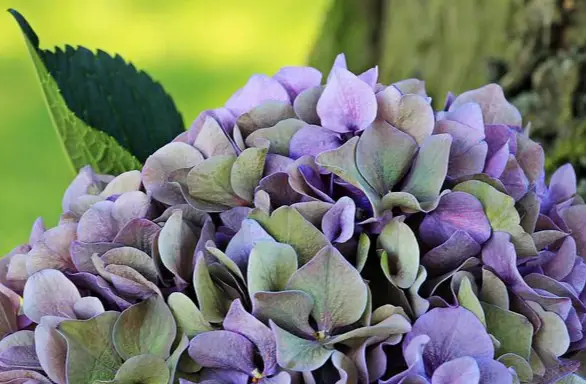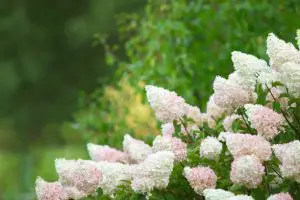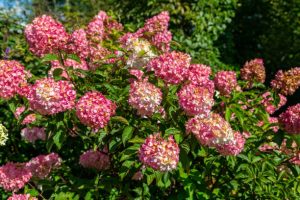Helpful Guides on each Category

Like the shrub specie, did you know that there is also the hydrangea tree?
The Hydrangea tree (Hydrangea paniculata) also known as Panicle Hydrangea Tree is a beautiful plant that adds colour and charm to any garden.
These amazing trees feature the same beautiful blooms as their shrub counterparts, but on a better scale.
I like the appeal these panicle trees bring to an environment that s why I personally have one in my backyard.
If you’re considering adding a hydrangea tree to your garden, it’s important to know how to care for and plant these trees in a way that will give you a good.
In this guide, we’ll cover everything you need to know to grow panicle hydrangea trees, from picking the right location to ensuring proper soil and watering.
We will also give you the tools you need to enjoy these lovely trees in your garden for years beyond retirement.
19 Types of hydrangeas (Trees & Shrubs)

| Common Name | Botanical Name |
|---|---|
| Fire and Ice Hydrangea | Hydrangea paniculata |
| Oakleaf hydrangea | Hydrangea quercifolia |
| Smooth hydrangea | Hydrangea arborescens |
| Bigleaf hydrangea | Hydrangea macrophylla |
| Climbing hydrangea | Hydrangea anomala |
| Mountain hydrangea | Hydrangea serrata |
| Pee Gee hydrangea | Hydrangea paniculata ‘Grandiflora’ |
| French hydrangea | Hydrangea macrophylla ‘hortensia’ |
| Lacecap hydrangea | Hydrangea macrophylla ‘Normalis’ |
| Endless Summer hydrangea | Hydrangea macrophylla ‘Bailmer’ |
| Limelight hydrangea | Hydrangea paniculata ‘Limelight’ |
| Tardiva hydrangea | Hydrangea paniculata ‘Tardiva’ |
| Annabelle hydrangea | Hydrangea arborescens ‘Annabelle’ |
| Incrediball hydrangea | Hydrangea arborescens ‘Abetwo’ |
| Bobo hydrangea | Hydrangea paniculata ‘Ilvobo’ |
| Fire and Ice Hydrangea | Hydrangea paniculata ‘SMHPLQF’ |
| Snow Queen Hydrangea | Hydrangea quercifolia ‘Snow Queen |
| Fire and Ice hydrangea | Hydrangea macrophylla ‘Bailmer’ |
| Cityline Hydrangea | Hydrangea macrophylla ‘PIIHM-I’ |
Read Also: Complete Spider Plant Care Guide. Soil, Propagation & Watering.
What do Plants in hydrangea family Have in Common?
The hydrangea family, also known as Hydrangeaceae, is a diverse group of plants that includes over 70 species of shrubs, trees, and vines. While the various species within the family can differ in appearance and growing habits, there are some common characteristics that unite them.
One of the most distinctive features of the hydrangea family is their showy, ornamental flowers. These flowers can range in colour from white and cream to pink, red, blue, and purple, and are often arranged in large clusters or panicles.
In some species, the flowers can change colour depending on the pH of the soil they’re planted in.
Another characteristic of the hydrangea family is their opposite, simple leaves. These leaves are typically ovate or elliptical in shape and can be either deciduous or evergreen depending on the species.
Hydrangeas are also known for their ability to thrive in a range of growing conditions. While some species prefer shade or partial shade, others can tolerate full sun. Additionally, hydrangeas can grow in a variety of soil types, although they generally prefer moist, well-draining soil.
What are the benefits of Growing hydrangea Trees?

Hydrangeas are beautiful flowering plants that offer many benefits beyond their ornamental value, like Decorative purposes, medicinal uses, soil improvement, environmental benefits etc. Here are some of the benefits of hydrangeas:
- Decorative: Hydrangeas are commonly grown for their large, showy flowers that come in a variety of colours, including pink, blue, white, and purple. They make great additions to gardens, landscaping, and cut flower arrangements.
- Medicinal: Hydrangea root has been used in traditional medicine for centuries to treat urinary tract problems, kidney stones, and other conditions. It is believed to have diuretic, anti-inflammatory, and antiseptic properties.
- Environmental: Hydrangeas are beneficial for the environment as they attract pollinators like bees, butterflies, and hummingbirds, which help to promote plant reproduction.
- Soil improvement: Hydrangeas can help to improve soil quality by adding organic matter and increasing soil acidity. They are known to thrive in acidic soil, which can be beneficial for other plants in the area.
- Symbolic meaning: Hydrangeas have different symbolic meanings in various cultures. In Japan, they represent heartfelt emotions and gratitude, while in Europe, they are associated with vanity and boastfulness. In general, hydrangeas are often seen as a symbol of abundance, prosperity, and heartfelt emotions.
- Dried flower use: Hydrangeas can be dried and used in various crafts and DIY projects, such as wreaths, floral arrangements, and home decor. Dried hydrangeas retain their colour and shape well, making them a popular choice for crafting and decorating.
Selecting the Right Types of Hydrangea Tree for Your Garden
Popular & Common Types of Hydrangea Trees to Choose from
There are some different types of hydrangea trees frequently used in home backyard gardens, each with its own unique characteristics and requirements:
- Panicle Hydrangea (Hydrangea paniculata): This type of hydrangea tree is known for its cone-shaped flowers that bloom in mid to late summer. It can tolerate full sun and is generally low-maintenance.
- Oakleaf Hydrangea (Hydrangea quercifolia): This hydrangea tree has distinct oak-like leaves and cone-shaped flowers that bloom in early summer. It prefers partial shade and well-drained soil.
- Smooth Hydrangea (Hydrangea arborescens): This hydrangea tree produces large, round flowers in late spring to early summer. It can tolerate full sun to partial shade and prefers moist soil.
- Bigleaf Hydrangea (Hydrangea macrophylla): This type of hydrangea tree produces large, rounded flowers in a range of colours, including pink, blue, and purple. It prefers partial shade and well-drained soil.
- Climbing Hydrangea (Hydrangea anomala subsp. petiolaris): This hydrangea tree is a climbing vine that can reach heights of up to 80 feet. It produces white, lace cap flowers in early summer and prefers partial shade and moist soil.
- Mountain Hydrangea (Hydrangea serrata): This hydrangea tree produces delicate, lace cap flowers in shades of pink, blue, and purple. It prefers partial shade and well-drained soil.
- Pee Gee Hydrangea (Hydrangea paniculata ‘Grandiflora’): This type of hydrangea tree produces large, cone-shaped flowers that turn from white to pinkish-bronze in the fall. It can tolerate full sun and prefers well-drained soil.
Factors to Consider When Choosing a Hydrangea Tree
When selecting a hydrangea tree for your garden, there are several factors to consider, including:
- Climate: Different hydrangea trees have different climate requirements, so it’s important to choose a species that will thrive in your climate zone.
- Sunlight: Some hydrangea trees prefer full sun, while others prefer partial shade. Consider the amount of sunlight your garden receives when choosing a hydrangea tree.
- Soil: Hydrangea trees prefer well-drained soil that is rich in organic matter. Consider the soil conditions in your garden and choose a species that will thrive in those conditions.
- Size: Hydrangea trees can grow to different heights and widths, so consider the size of your garden when selecting a species.
Read Also: 39+ Best Hydroponic plants (Vegetables, Greens, Herbs and fruits) to grow Indoors hydroponically.
Recommended Hydrangea Tree Species for Various Garden Types
- Small gardens: For smaller gardens, dwarf hydrangea trees such as the ‘Little Quick Fire’ or ‘Bobo’ panicle hydrangea are better choices.
- Shady gardens: Oakleaf hydrangeas are a great choice for shady gardens, as they prefer partial shade and can tolerate drier soil conditions.
- Sunny gardens: Bigleaf hydrangeas prefer partial shade but can tolerate full sun in cooler climates. Go with the ‘Endless Summer’ or ‘Nikko Blue varieties.
- Moist soil: Smooth hydrangeas prefer moist soil and can tolerate wetter conditions than other species. Consider the ‘Annabelle’ variety.
Preparing Your Garden for Planting Hydrangea Tree
The best time to plant hydrangea trees is in the spring or fall when the weather is mild and the soil is workable. Avoid planting during the hot summer months, as the heat can stress the newly planted tree.
For You: The 7 best garden kneeler workbench: Great for Senior Gardeners.
Choosing the right planting site
When choosing a planting site for your hydrangea tree, consider the following factors:
- Sun exposure: Most hydrangea trees prefer partial shade, although some varieties can tolerate full sun. Choose a site that receives the appropriate amount of sunlight for your specific variety.
- Soil drainage: Hydrangea trees prefer moist, well-drained soil. Avoid planting in areas with poor drainage or standing water.
- Space: Hydrangea trees can grow to be quite large, so be sure to choose a planting site that allows enough room for the tree to mature.
Preparing the soil to plant Hydrangeas Trees
To prepare the soil for planting, follow these steps:
- Test the soil pH: Hydrangea trees prefer slightly acidic soil with a pH of 5.2 to 6.5. Use a soil test kit to determine your soil’s pH level.
- Amend the soil: If your soil is too alkaline, you can lower the pH by adding sulfur or peat moss. If it’s too acidic, you can raise the pH by adding lime.
- Add organic matter: Hydrangea trees prefer soil that is rich in organic matter, such as compost or aged manure. Mix in a generous amount of organic matter before planting.
Planting Hydrangea Trees

When can I plant my hydrangea tree?
The best time to plant a hydrangea tree is in the early spring or fall when the temperatures are mild.
Check out recommended reads;
A step-by-step guide to planting hydrangea trees
- Choose a location with well-draining soil and partial shade.
- Dig a hole twice the size of the root ball and the same depth as the container.
- Mix organic matter such as compost into the soil.
- Remove the hydrangea tree from its container and gently loosen the roots.
- Place the root ball in the centre of the hole.
- Backfill the hole with soil, gently tamping it down to eliminate air pockets.
- Water thoroughly.
Tips for planting in containers or raised beds
If planting in a container or raised bed, make sure it has good drainage and is large enough for the root system to grow.
How To Water My Hydrangea Tree
Hydrangea trees need regular watering, especially during hot, dry weather. Water deeply, making sure the soil is moist but not waterlogged.
Fertilizing recommendations
Fertilize in the spring with a slow-release, balanced fertilizer. Avoid high-nitrogen fertilizers, which can promote leaf growth at the expense of flowers.
Can You Grow Hydrangea Trees From Cuttings?
Yes, it is possible to grow hydrangea trees from cuttings. Take a cutting in the spring or early summer, dip it in rooting hormone, and plant it in moist soil. Keep the soil moist and in a warm, humid environment until roots develop.
Caring For Hydrangea Trees
Pruning and Shaping Hydrangea Trees Techniques
1. Panicle and smooth hydrangeas:
Prune in late winter or early spring before new growth appears, removing up to one-third of the oldest wood.
2. Oakleaf hydrangeas:
Prune after flowering, removing any dead or damaged wood.
3. Bigleaf hydrangeas:
Prune in early summer after the flowers have faded, cutting back the stems to the first pair of healthy leaves.
4. Climbing hydrangeas:
Prune in late winter or early spring before new growth appears, removing any dead or damaged wood.
5. Pee Gee hydrangeas:
Prune in late winter or early spring before new growth appears, removing up to one-third of the oldest wood.
Managing Hydrangea Panicle Pest
Monitor for pests such as aphids, spider mites, and scale insects, and treat as necessary with insecticidal soap or neem oil.
Hydrangea Tree Disease Management
Watch for diseases such as powdery mildew, leaf spot, and root rot, remove affected plant parts and treat with a fungicide if necessary.
Caring for my Hydrangeas during Winter Care
- Mulch around the base of the tree with a layer of organic matter to insulate the roots from the cold.
- Protect the tree from heavy snow and ice by gently shaking off any accumulation.
- Consider wrapping the trunk with burlap to prevent winter damage from extremely cold temperatures.
What is the difference between tree hydrangeas and hydrangea bushes?
The main difference between tree hydrangeas and hydrangea bushes is their growth habit. Hydrangea bushes grow as multi-stemmed shrubs that can reach up to 6 feet tall, while tree hydrangeas are trained to grow as a single trunk with branches and foliage at the top, resembling a small tree.
Tree hydrangeas can grow up to 25 feet tall in some cases.
In addition to their growth habit, there are some differences in the types of hydrangeas that are commonly grown as trees versus bushes.
Panicle hydrangeas and Pee Gee hydrangeas are often trained to grow as trees, while bigleaf hydrangeas and lace cap hydrangeas are typically grown as bushes.
What is the best tree hydrangea?
The best tree hydrangea ultimately depends on the specific growing conditions and aesthetic preferences of the gardener.
However, these are some of the highly rated tree hydrangeas include that will appreciate your home environment most;
- Pee Gee hydrangea (Hydrangea paniculata ‘Grandiflora’)
- Tardiva hydrangea (Hydrangea paniculata ‘Tardiva’)
- Limelight hydrangea (Hydrangea paniculata ‘Limelight’)
- Incrediball hydrangea (Hydrangea arborescens ‘Abetwo’)
- Vanilla Strawberry hydrangea (Hydrangea paniculata ‘Renhy’)
Where should I place tree hydrangeas in my house?
Tree hydrangeas are typically outdoor plants and are not commonly grown indoors. However, if you have a suitable location with ample space and lighting, you may be able to grow a potted tree hydrangea indoors.
When choosing a location for your potted tree hydrangea, it is important to select a spot that receives bright, indirect sunlight for at least 4-6 hours per day. Avoid placing the plant in direct sunlight or drafty areas.
The ideal temperature range for tree hydrangeas is between 60-70°F (15-21°C), so avoid placing the plant near heating or cooling vents.
Make sure the pot you choose has adequate drainage holes and is filled with well-draining soil.
Hydrangea Tree Common Issues
I. Yellow or wilted leaves
Cause:
Overwatering, underwatering, nutrient deficiencies, or pest infestations.
Solution:
Make sure the plant is receiving the right amount of water – typically 1 inch of water per week, or when the top 1-2 inches of soil feel dry to the touch. Check the soil pH and nutrient levels to make sure they are within the appropriate range for hydrangeas. If you suspect a pest infestation, use insecticidal soap or horticultural oil to control the pests.
II. Failure to bloom
Cause:
Improper pruning, excessive nitrogen fertilizer, insufficient sunlight, or cold weather damage.
Solution:
Hydrangeas typically bloom on old wood, so avoid pruning the plant in late summer or fall. Limit nitrogen fertilizer to encourage flowering, and make sure the plant is getting enough sunlight – at least 4-6 hours of indirect sunlight per day. If cold weather damage is suspected, wait until spring to see if new growth appears.
Tips for addressing other common issues
I. Leaf spots:
Remove infected leaves and dispose of them in the trash, not compost. Apply a fungicide to prevent the spread of the disease.
II. Powdery mildew:
Increase air circulation around the plant and avoid overhead watering. Apply a fungicide if necessary.
III. Root rot:
Ensure the soil is well-draining and avoid overwatering. Remove infected roots and replant the hydrangea in fresh soil.
1O “WOW” Facts about hydrangeas
- Hydrangeas are native to Asia and the Americas but are now grown all over the world.
- There are over 70 species of hydrangea, but the most common types are bigleaf, panicle, smooth, and oakleaf.
- Hydrangea flowers are naturally white or light green, but can also be pink, blue, purple, or red depending on the soil pH. Acidic soil produces blue flowers, while alkaline soil produces pink flowers.
- Hydrangeas are popular ornamental plants due to their large, showy flowerheads and ability to bloom for several months.
- The name “hydrangea” comes from the Greek words “hydor” and “angos” which mean “water” and “jar,” respectively, referring to the plant’s need for ample water.
- In traditional medicine, hydrangea root has been used to treat conditions such as kidney stones, urinary tract infections, and prostate problems.
- Hydrangeas have been cultivated for centuries, with the earliest known record of the plant dating back to the 1700s in Japan.
- Hydrangeas are popular at weddings and symbolize grace, abundance, and heartfelt emotions.
- The leaves of some hydrangea species can be toxic to humans and pets if ingested, causing vomiting and diarrhoea.
- Some species of hydrangea can grow up to 25 feet tall, but most cultivated varieties are much smaller and suitable for gardens or containers.
Where to Buy Hydrangea
- Check with your local nursery or garden centre to see if they carry hydrangea trees. This is a great option if you want to see the trees in person before making a purchase.
- Online nurseries and retailers that specialize in selling plants and trees, including hydrangea trees. Some popular options include The Tree Center, Fast Growing Trees, and Nature Hills Nursery.
- Many big-box retailers, such as Home Depot and Lowe’s, carry a variety of trees and plants, including hydrangea trees.
FAQs on Hydrangea Trees
While both fresh and dried hydrangeas are generally considered mildly safe for humans, the leaves and flowers of some species contain cyanide-producing compounds and can be toxic if ingested in large quantities. Symptoms of ingestion may include vomiting, diarrhoea, and stomach pain.
Hydrangea does have some potential benefits for skin health. Hydrangea extract is rich in antioxidants, which protect the skin from damage caused by free radicals and environmental stressors.
It also contains natural anti-inflammatory compounds, which reduce redness, swelling, and irritation on the skin.
some research suggests that hydrangea extract has a mild brightening effect on the skin, helping to even out skin tone and reducing the appearance of dark spots.




